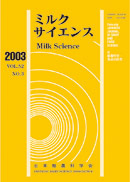All issues

Volume 52 (2003)
- Issue 3 Pages 127-
- Issue 2 Pages 69-
- Issue 1 Pages 1-
Predecessor
Volume 52, Issue 3
Displaying 1-2 of 2 articles from this issue
- |<
- <
- 1
- >
- >|
Original Reports
-
Chigen Tsukamoto, Hiromasa Asano, Tomotada Ono2003 Volume 52 Issue 3 Pages 127-136
Published: 2003
Released on J-STAGE: March 15, 2014
JOURNAL FREE ACCESSA new trucking method of liquids, called the Softtank system, has recently been developed and given attentions to improve conventional trucking method. The system is equipped with a size-free flexible bag with a pressure-resistant watertight zipper. It could be installed on common trucks with metal frames to prevent agitation of the liquid. Unique characteristics of this system are as follows: 1) Load volume of liquid is free. 2) Consolidated service is available. 3) The system can be folded into smaller size, so that other goods can be loaded on the return trip. 4) Attached zipper makes cleaning of the inside of the bags easy and the sanitation task become independent from the drivers' responsibility. 5) It is recyclable for several hundred times.
By using raw cow milks, the Softtank system was compared with a conventional trucking method on the quality control including sanitation, temperature, and bacteria counts. In the summer of 2001, test trials were performed five times. The average of the transportation distance and duration were about 600 km and 19 hours, and provided the following results:
1) Just before loading the milk, the cleanness of the containers was tested with a commercial ATP detection kit. The Softtank containers were sufficiently clean at each trial, but the test detected microorganisms of contamination in some parts of the container of the tanktrucks. The contamination diminished by the fifth trial. The cause of the contamination of the tanktruck appeared to be a lack of explicit sanitation specifications to the sanitation operators.
2) Increased temperature of the milk during trucking was observed at the upper part of the container of tanktrucks. Since the increase was not depended on the outdoor temperature, it might be caused by the increased temperature of head space (upper part) of container, which is caused by the direct rays of the sun.
3) No increase of microorganisms was found throughout the trucking trials.
4) Fat content of the milk transported by the tanktrucks was increased about 0.1%. This was thought that some of fat globules were disrupted by churning and large sized fat globules (cream) were produced during the trucking by the tanktrucks. This phenomenon was not observed in the Softtank system.
These results indicate that the Softtank system is a superior trucking method to achieve better sanitation of the containers and maintain higher quality of raw cow milk.View full abstractDownload PDF (369K) -
Bikash C. Ghosh, T. Sienkiewicz, K. Krenkel2003 Volume 52 Issue 3 Pages 137-146
Published: 2003
Released on J-STAGE: March 15, 2014
JOURNAL FREE ACCESSCheddar type cheese was manufactured from milk using a commercial direct vat mesophilic starter culture. Varying amount of lyophilized crude extra cellular enzymes from Brevibacterium linens was mixed with salt and incorporated into cheese after milling to accelerate ripening process. Sensory and physico-chemical evaluation were carried out on control and experimental cheese over 16 wk at 2 wk interval. No off flavour, no bitterness and no significant differences on sensory parameters between experimental and control cheese was observed. Changes in moisture loss, pH and hardness in the experimental cheese did not differ significantly from the control. Cheeses with higher amount of enzymes contained higher levels of Non Protein Nitrogen and Non Casein Nitrogen than control. Increase in Amino nitrogen was higher in experimental cheeses than control. None of the cheeses showed complete degradation of αs1-casein at the end of 16 wk ripening. Hydrolysis rate of αs1-casein was more than β-casein during ripening. As a result of degradation one major peptide formation started after 2 wk and its degradation took place after 6 wk onward. This study revealed that crude extra cellular enzymes from B. linens are not effective in accelerating the ripening of Cheddar type cheeses as the enzymes are active in alkaline or neutral pH and may not be stable at pH 5.20-5.03 which is the normal pH at the initial stage of ripening.View full abstractDownload PDF (161K)
- |<
- <
- 1
- >
- >|